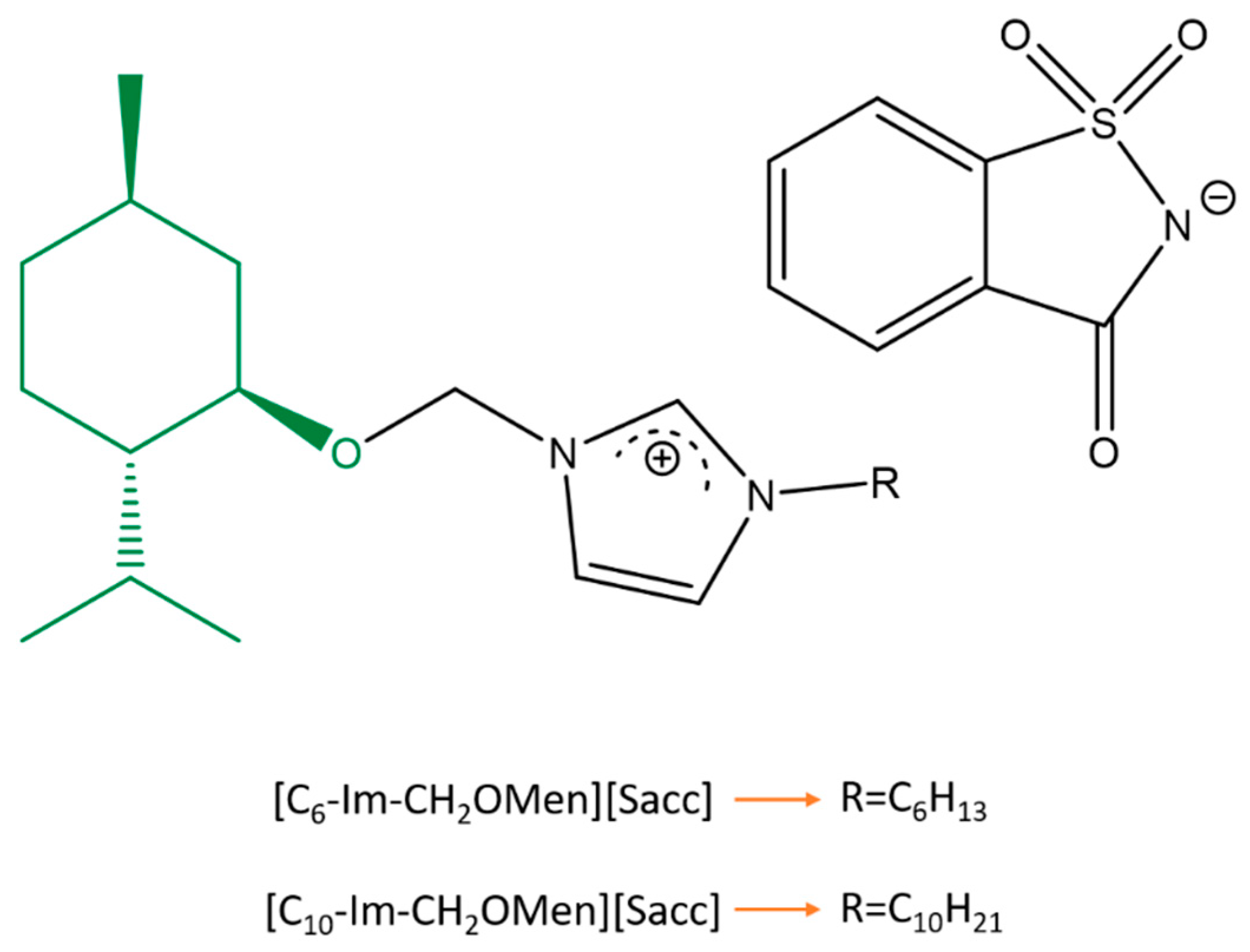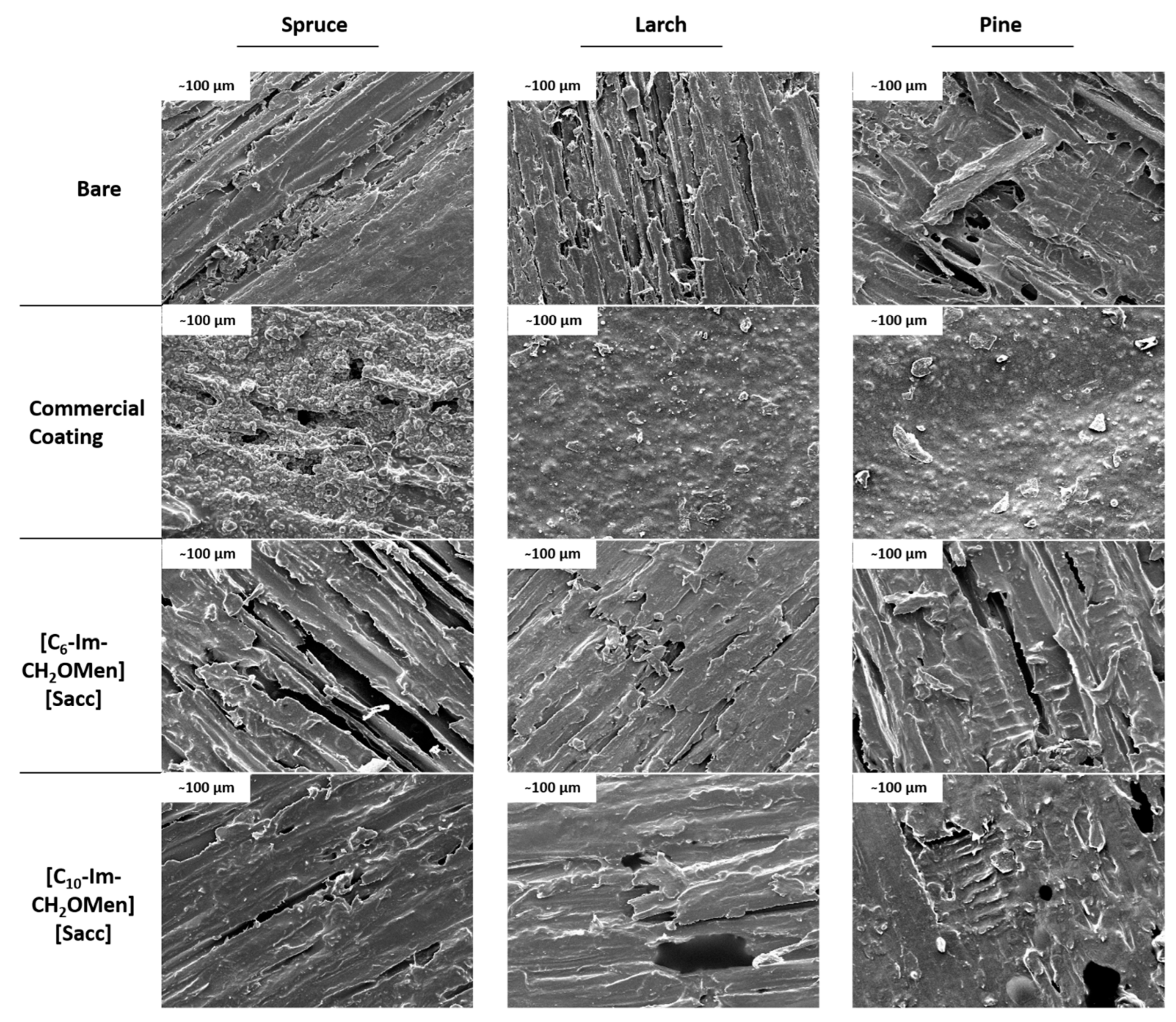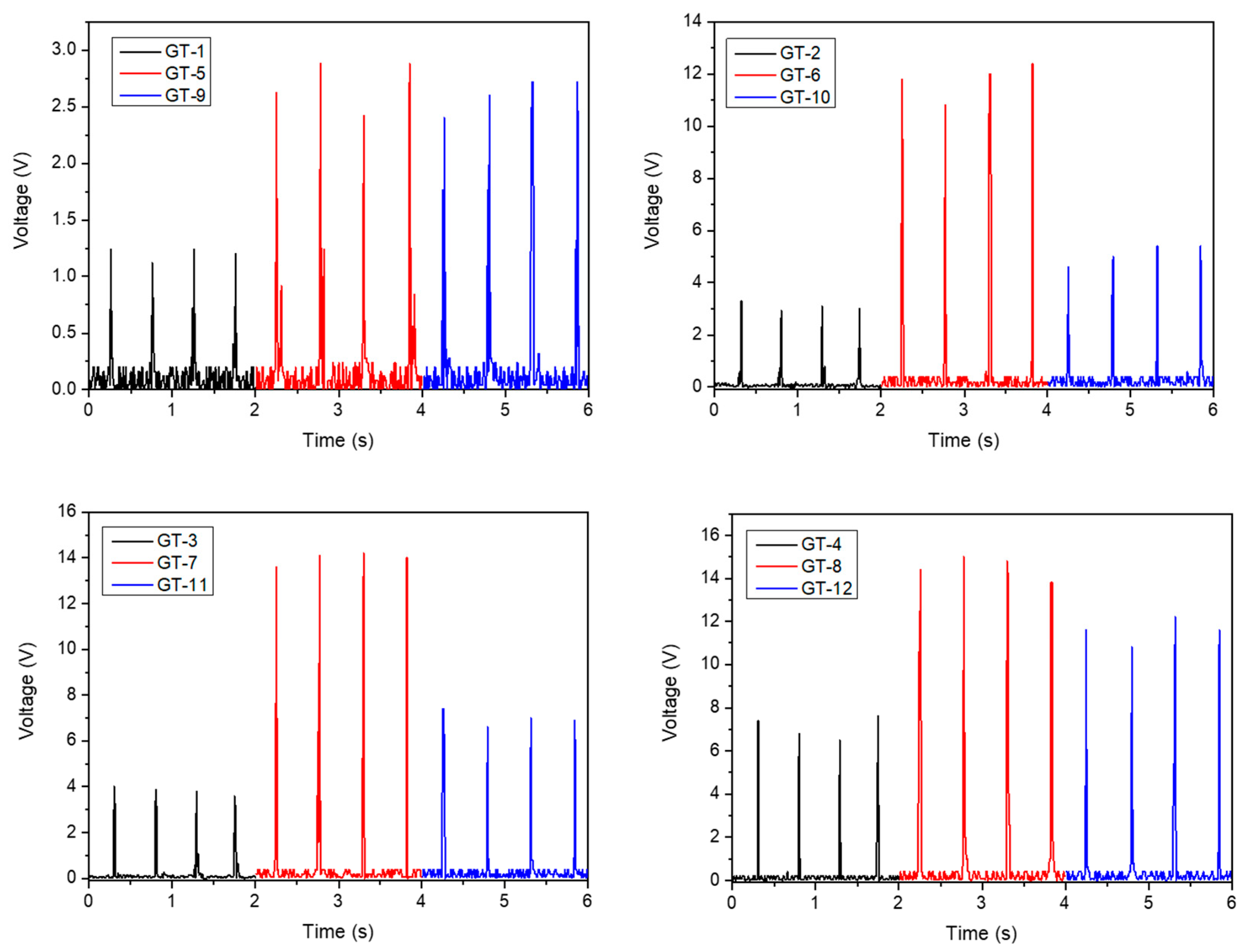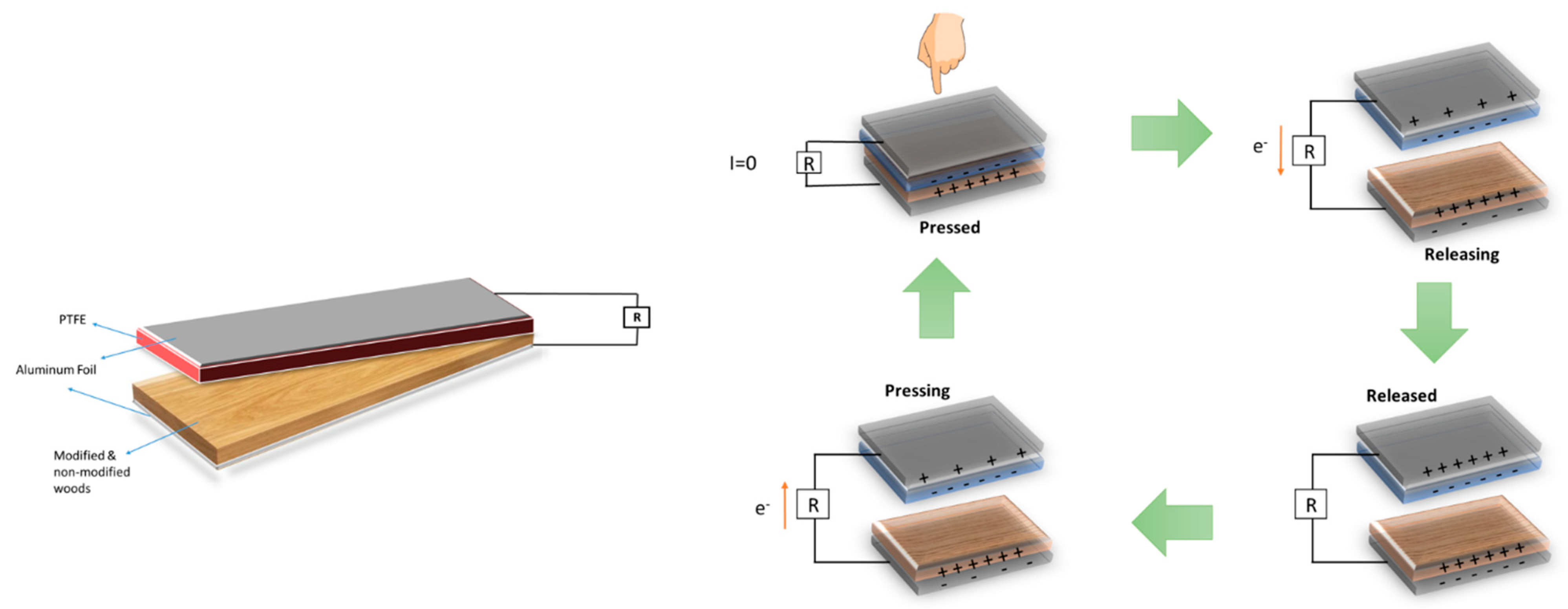From Biological Source to Energy Harvesting Device: Surface Protective Ionic Liquid Coatings for Electrical Performance Enhancement of Wood-Based Electronics
Abstract
:1. Introduction
2. Results and Discussion
Electrical Measurements
3. Materials and Methods
3.1. Materials
3.2. Preparation of Wood Samples
3.3. Device Fabrication
3.4. Instrumentation and Device Characterization
4. Conclusions
Supplementary Materials
Author Contributions
Funding
Data Availability Statement
Acknowledgments
Conflicts of Interest
Sample Availability
References
- Asdrubali, F.; Ferracuti, B.; Lombardi, L.; Guattari, C.; Evangelisti, L.; Grazieschi, G. A review of structural, thermo-physical, acoustical, and environmental properties of wooden materials for building applications. Build. Environ. 2017, 114, 307–332. [Google Scholar] [CrossRef]
- Bang, J.; Moon, I.K.; Jeon, Y.P.; Ki, B.; Oh, J. Fully wood-based green triboelectric nanogenerators. Appl. Surf. Sci. 2021, 567, 150806. [Google Scholar] [CrossRef]
- Deng, J.; Xiong, T.; Wang, H.; Zheng, A.; Wang, Y. Effects of cellulose, hemicellulose, and lignin on the structure and morphology of porous carbons. ACS Sustain. Chem. Eng. 2016, 4, 3750–3756. [Google Scholar] [CrossRef]
- Kumar, R.; Kumar, K.; Sahoo, P.; Bhowmik, S. Study of mechanical properties of wood dust reinforced epoxy composite. Procedia Mater. Sci. 2014, 6, 551–556. [Google Scholar] [CrossRef]
- Lee, K.Y.; Chun, J.; Lee, J.H.; Kim, K.N.; Kang, N.R.; Kim, J.Y.; Kim, M.H.; Shin, K.S.; Gupta, M.K.; Baik, J.M. Hydrophobic sponge structure-based triboelectric nanogenerator. Adv. Mater. 2014, 26, 5037–5042. [Google Scholar] [CrossRef] [PubMed]
- Bi, W.; Li, H.; Hui, D.; Gaff, M.; Lorenzo, R.; Corbi, I.; Corbi, O.; Ashraf, M. Effects of chemical modification and nanotechnology on wood properties. Nanotechnol. Rev. 2021, 10, 978–1008. [Google Scholar] [CrossRef]
- Zhu, M.; Song, J.; Li, T.; Gong, A.; Wang, Y.; Dai, J.; Yao, Y.; Luo, W.; Henderson, D.; Hu, L. Highly anisotropic, highly transparent wood composites. Adv. Mater. 2016, 28, 5181–5187. [Google Scholar] [CrossRef]
- Song, J.; Chen, C.; Yang, Z.; Kuang, Y.; Li, T.; Li, Y.; Huang, H.; Kierzewski, I.; Liu, B.; He, S. Highly compressible, anisotropic aerogel with aligned cellulose nanofibers. ACS Nano 2018, 12, 140–147. [Google Scholar] [CrossRef]
- Song, J.; Chen, C.; Zhu, S.; Zhu, M.; Dai, J.; Ray, U.; Li, Y.; Kuang, Y.; Li, Y.; Quispe, N. Processing bulk natural wood into a high-performance structural material. Nature 2018, 554, 224–228. [Google Scholar] [CrossRef]
- Hao, S.; Jiao, J.; Chen, Y.; Wang, Z.L.; Cao, X. Natural wood-based triboelectric nanogenerator as self-powered sensing for smart homes and floors. Nano Energy 2020, 75, 104957. [Google Scholar] [CrossRef]
- Shi, X.; Luo, J.; Luo, J.; Li, X.; Han, K.; Li, D.; Cao, X.; Wang, Z.L. Flexible wood-based triboelectric self-powered smart home system. ACS Nano 2022, 16, 3341–3350. [Google Scholar] [CrossRef]
- Luo, J.; Wang, Z.; Xu, L.; Wang, A.C.; Han, K.; Jiang, T.; Lai, Q.; Bai, Y.; Tang, W.; Fan, F.R. Flexible and durable wood-based triboelectric nanogenerators for self-powered sensing in athletic big data analytics. Nat. Commun. 2019, 10, 5147. [Google Scholar] [CrossRef]
- Song, W.-Z.; Qiu, H.-J.; Zhang, J.; Yu, M.; Ramakrishna, S.; Wang, Z.L.; Long, Y.-Z. Sliding mode direct current triboelectric nanogenerators. Nano Energy 2021, 90, 106531. [Google Scholar] [CrossRef]
- He, C.; Zhu, W.; Chen, B.; Xu, L.; Jiang, T.; Han, C.B.; Gu, G.Q.; Li, D.; Wang, Z.L. Smart floor with integrated triboelectric nanogenerator as energy harvester and motion sensor. ACS Appl. Mater. Interfaces 2017, 9, 26126–26133. [Google Scholar] [CrossRef]
- Zhang, C.; Mo, J.; Fu, Q.; Liu, Y.; Wang, S.; Nie, S. Wood-cellulose-fiber-based functional materials for triboelectric nanogenerators. Nano Energy 2021, 81, 105637. [Google Scholar] [CrossRef]
- Wu, C.; Wang, A.C.; Ding, W.; Guo, H.; Wang, Z.L. Triboelectric nanogenerator: A foundation of the energy for the new era. Adv. Energy Mater. 2019, 9, 1802906. [Google Scholar] [CrossRef]
- Yi, F.; Zhang, Z.; Kang, Z.; Liao, Q.; Zhang, Y. Recent advances in triboelectric nanogenerator-based health monitoring. Adv. Funct. Mater. 2019, 29, 1808849. [Google Scholar] [CrossRef]
- Choi, J.; Jung, I.; Kang, C.-Y. A brief review of sound energy harvesting. Nano Energy 2019, 56, 169–183. [Google Scholar] [CrossRef]
- Yiğit Arkan, M.Z.; Kınas, Z.; Arkan, E.; Gökçe, C.O.; Kara, K.; Karabiber, A.; Kuş, M.; Özel, F. Molecular engineering-device efficiency relation: Performance boosting of triboelectric nanogenerator through doping of small molecules. Int. J. Energy Res. 2022, 46, 23517–23529. [Google Scholar] [CrossRef]
- Lee, C.; Yang, S.; Choi, D.; Kim, W.; Kim, J.; Hong, J. Chemically surface-engineered polydimethylsiloxane layer via plasma treatment for advancing textile-based triboelectric nanogenerators. Nano Energy 2019, 57, 353–362. [Google Scholar] [CrossRef]
- Arkan, E.; Karabiber, A.; Topçu, M.A.; Kinas, Z.; Sarilmaz, A.; Ozel, S.S.; Ozel, F. Nano-Ceria Based TENGs: Effect of dopant structure on energy harvesting performance. Surf. Interfaces 2023, 37, 102683. [Google Scholar] [CrossRef]
- Zhao, T.; Han, Y.; Qin, L.; Guan, H.; Xing, L.; Li, X.; Xue, X.; Li, G.; Zhan, Y. Bidirectional modulation of neural plasticity by self-powered neural stimulation. Nano Energy 2021, 85, 106006. [Google Scholar] [CrossRef]
- Wang, M.; Zi, G.; Liu, J.; Song, Y.; Zhao, X.; Wang, Q.; Zhao, T. Self-Powered Biosensor for Specifically Detecting Creatinine in Real Time Based on the Piezo-Enzymatic-Reaction Effect of Enzyme-Modified ZnO Nanowires. Biosensors 2021, 11, 342. [Google Scholar] [CrossRef] [PubMed]
- Nafari, A.; Sodano, H. Surface morphology effects in a vibration based triboelectric energy harvester. Smart Mater. Struct. 2017, 27, 015029. [Google Scholar] [CrossRef]
- Lin, Y.; Zhan, X. Oligomer molecules for efficient organic photovoltaics. Acc. Chem. Res. 2016, 49, 175–183. [Google Scholar] [CrossRef]
- Lin, Y.; Li, Y.; Zhan, X. Small molecule semiconductors for high-efficiency organic photovoltaics. Chem. Soc. Rev. 2012, 41, 4245–4272. [Google Scholar] [CrossRef]
- Llaver, M.; Fiorentini, E.F.; Quintas, P.Y.; Oviedo, M.N.; Arenas, M.B.B.; Wuilloud, R.G. Task-specific ionic liquids: Applications in sample preparation and the chemistry behind their selectivity. Adv. Sample Prep. 2021, 1, 100004. [Google Scholar] [CrossRef]
- Liu, H.; Liu, Y.; Li, J. Ionic liquids in surface electrochemistry. Phys. Chem. Chem. Phys. 2010, 12, 1685–1697. [Google Scholar] [CrossRef]
- Li, Q.; Jiang, J.; Li, G.; Zhao, W.; Zhao, X.; Mu, T. The electrochemical stability of ionic liquids and deep eutectic solvents. Sci. China Chem. 2016, 59, 571–577. [Google Scholar] [CrossRef]
- Kazemiabnavi, S.; Zhang, Z.; Thornton, K.; Banerjee, S. Electrochemical stability window of imidazolium-based ionic liquids as electrolytes for lithium batteries. J. Phys. Chem. B 2016, 120, 5691–5702. [Google Scholar] [CrossRef]
- Kosmulski, M.; Gustafsson, J.; Rosenholm, J.B. Thermal stability of low temperature ionic liquids revisited. Thermochim. Acta 2004, 412, 47–53. [Google Scholar] [CrossRef]
- Cassity, C.G.; Mirjafari, A.; Mobarrez, N.; Strickland, K.J.; O’Brien, R.A.; Davis, J.H. Ionic liquids of superior thermal stability. Chem. Commun. 2013, 49, 7590–7592. [Google Scholar] [CrossRef]
- Mahadeva, S.K.; Kim, J. An electro-active paper actuator made with cellulose–polypyrrole–ionic liquid nanocomposite: Influence of ionic liquid concentration, type of anion and humidity. Smart Mater. Struct. 2010, 19, 105014. [Google Scholar] [CrossRef]
- Feder-Kubis, J.; Zabielska-Matejuk, J.; Stangierska, A.; Przybylski, P.; Jacquemin, J.; Geppert-Rybczynska, M. Toward designing “sweet” ionic liquids containing a natural terpene moiety as effective wood preservatives. ACS Sustain. Chem. Eng. 2019, 7, 15628–15639. [Google Scholar] [CrossRef]
- Wasserscheid, P.; Keim, W. Ionic liquids—New “solutions” for transition metal catalysis. Angew. Chem. Int. Ed. 2000, 39, 3772–3789. [Google Scholar] [CrossRef]
- Tang, S.; Baker, G.A.; Zhao, H. Ether-and alcohol-functionalized task-specific ionic liquids: Attractive properties and applications. Chem. Soc. Rev. 2012, 41, 4030–4066. [Google Scholar] [CrossRef]
- Rogers, R.D.; Seddon, K.R. Ionic liquids--solvents of the future? Science 2003, 302, 792–793. [Google Scholar] [CrossRef]
- Feder-Kubis, J.; Wnętrzak, A.; Suchodolski, J.; Mitkowski, P.T.; Krasowska, A. Imidazolium room-temperature ionic liquids with alkoxymethyl substituent: A quest for improved microbiological selectivity. Chem. Eng. J. 2022, 442, 136062. [Google Scholar] [CrossRef]
- Olejniczak, A.; Stachowiak, W.; Rzemieniecki, T.; Niemczak, M. Adjustment of the Structure of the Simplest Amino Acid Present in Nature—Glycine, toward More Environmentally Friendly Ionic Forms of Phenoxypropionate-Based Herbicides. Int. J. Mol. Sci. 2023, 24, 1360. [Google Scholar] [CrossRef]
- Stoimenovski, J.; MacFarlane, D.R. Enhanced membrane transport of pharmaceutically active protic ionic liquids. Chem. Commun. 2011, 47, 11429–11431. [Google Scholar] [CrossRef]
- Moshikur, R.M.; Chowdhury, M.R.; Moniruzzaman, M.; Goto, M. Biocompatible ionic liquids and their applications in pharmaceutics. Green Chem. 2020, 22, 8116–8139. [Google Scholar] [CrossRef]
- Stathatos, E.; Lianos, P.; Zakeeruddin, S.; Liska, P.; Grätzel, M. A quasi-solid-state dye-sensitized solar cell based on a sol− gel nanocomposite electrolyte containing ionic liquid. Chem. Mater. 2003, 15, 1825–1829. [Google Scholar] [CrossRef]
- Armand, M.; Endres, F.; MacFarlane, D.R.; Ohno, H.; Scrosati, B. Ionic-liquid materials for the electrochemical challenges of the future. Nat. Mater. 2009, 8, 621–629. [Google Scholar] [CrossRef] [PubMed]
- Del Sesto, R.E.; McCleskey, T.M.; Burrell, A.K.; Baker, G.A.; Thompson, J.D.; Scott, B.L.; Wilkes, J.S.; Williams, P. Structure and magnetic behavior of transition metal based ionic liquids. Chem. Commun. 2008, 447–449. [Google Scholar] [CrossRef]
- Mallick, B.; Balke, B.; Felser, C.; Mudring, A.V. Dysprosium room-temperature ionic liquids with strong luminescence and response to magnetic fields. Angew. Chem. Int. Ed. 2008, 47, 7635–7638. [Google Scholar] [CrossRef]
- Giernoth, R. Task-specific ionic liquids. Angew. Chem. Int. Ed. 2010, 49, 2834–2839. [Google Scholar] [CrossRef]
- Yokozeki, A.; Shiflett, M.B. Separation of carbon dioxide and sulfur dioxide gases using room-temperature ionic liquid [hmim][Tf2N]. Energy Fuels 2009, 23, 4701–4708. [Google Scholar] [CrossRef]
- Bates, E.D.; Mayton, R.D.; Ntai, I.; Davis, J.H. CO2 capture by a task-specific ionic liquid. J. Am. Chem. Soc. 2002, 124, 926–927. [Google Scholar] [CrossRef]
- Smiglak, M.; Metlen, A.; Rogers, R.D. The Second Evolution of Ionic Liquids: From Solvents and Separations to Advanced Materials Energetic Examples from the Ionic Liquid Cookbook. Acc. Chem. Res. 2007, 40, 1182–1192. [Google Scholar] [CrossRef]
- Pedro, S.N.; Freire, C.S.R.; Silvestre, A.J.; Freire, M.G. The role of ionic liquids in the pharmaceutical field: An overview of relevant applications. Int. J. Mol. Sci. 2020, 21, 8298. [Google Scholar] [CrossRef]
- Hough, W.L.; Rogers, R.D. Ionic liquids then and now: From solvents to materials to active pharmaceutical ingredients. Bull. Chem. Soc. Jpn. 2007, 80, 2262–2269. [Google Scholar] [CrossRef]
- Shamshina, J.L.; Berton, P.; Wang, H.; Zhou, X.; Gurau, G.; Rogers, R.D. Ionic liquids in pharmaceutical industry. In Green Techniques for Organic Synthesis and Medicinal Chemistry; John Wiley & Sons, Ltd.: Hoboken, NJ, USA, 2018; pp. 539–577. [Google Scholar] [CrossRef]
- Singh, S.K.; Savoy, A.W. Ionic liquids synthesis and applications: An overview. J. Mol. Liq. 2020, 297, 112038. [Google Scholar] [CrossRef]
- Zabielska-Matejuk, J.; Feder-Kubis, J.; Stangierska, A.; Przybylski, P. Chiral ionic liquids with a (−)-menthol component as wood preservatives. Holzforschung 2017, 71, 751–757. [Google Scholar] [CrossRef]
- Adamson, A.W.; Gast, A.P. Physical Chemistry of Surfaces; Interscience Publishers: New York, NY, USA, 1967; Volume 150. [Google Scholar]
- Liu, D.; Liu, J.; Yang, M.; Cui, N.; Wang, H.; Gu, L.; Wang, L.; Qin, Y. Performance enhanced triboelectric nanogenerator by taking advantage of water in humid environments. Nano Energy 2021, 88, 106303. [Google Scholar] [CrossRef]
- Liu, L.; Zhao, Z.; Li, Y.; Li, X.; Liu, D.; Li, S.; Gao, Y.; Zhou, L.; Wang, J.; Wang, Z.L. Achieving Ultrahigh Effective Surface Charge Density of Direct-Current Triboelectric Nanogenerator in High Humidity. Small 2022, 18, 2201402. [Google Scholar] [CrossRef]
- Gao, L.; McCarthy, T.J. A perfectly hydrophobic surface (θA/θR = 180/180). J. Am. Chem. Soc. 2006, 128, 9052–9053. [Google Scholar] [CrossRef]
- Mirgorod, Y.A. Relationship between free energy and hydrocarbon chain length in the transfer of hydrocarbons and alcohols into aqueous solutions of tetraalkylammonium salts. J. Struct. Chem. 1982, 23, 307–309. [Google Scholar] [CrossRef]
- Nasiri, R. Revisiting kinetic boundary conditions at the surface of fuel droplet hydrocarbons: An atomistic computational fluid dynamics simulation. Sci. Rep. 2016, 6, 25572. [Google Scholar] [CrossRef]
- Macfarlane, D.R.; Meakin, P.; Sun, J.; Amini, N.; Forsyth, M. Pyrrolidinium imides: A new family of molten salts and conductive plastic crystal phases. J. Phys. Chem. B 1999, 103, 4164–4170. [Google Scholar] [CrossRef]
- Arkan, M.Z.; Kinas, Z.; Yalcin, E.; Arkan, E.; Özel, F.; Karabiber, A.; Chorążewski, M. One Material-Opposite Triboelectrification: Molecular Engineering Regulated Triboelectrification on Silica Surface to Enhance TENG Efficiency. Molecules 2023, 28, 5662. [Google Scholar] [CrossRef]
- Alptekin, H.; Arkan, E.; Özbek, C.; Can, M.; Farzaneh, A.; Sütçü, M.; Okur, S.; Cobley, A.J. Water affinity guided tunable superhydrophobicity and optimized wettability of selected natural minerals. J. Coat. Technol. Res. 2019, 16, 199–211. [Google Scholar] [CrossRef]
- Arkan, E.; Arkan, M.Z.Y.; Unal, M.; Yalcin, E.; Aydin, H.; Çelebi, C.; Can, M.; Tozlu, C.; Demic, S. Performance enhancement of inverted perovskite solar cells through interface engineering by TPD based bidentate self-assembled monolayers. Opt. Mater. 2020, 105, 109910. [Google Scholar] [CrossRef]









| Sample | Wood | Coating | Contact Angle | Weight Loss |
|---|---|---|---|---|
| GT-1 | Spruce | Bare | 18.9° | 97.6% |
| GT-2 | Spruce | Commercial Coating | 86.3° | 99.7% |
| GT-3 | Spruce | [C10-Im-CH2OMen][Sacc] | 20.9° | 84.1% |
| GT-4 | Spruce | [C6-Im-CH2OMen][Sacc] | 27.3° | 83.1% |
| GT-5 | Larch | Bare | 32.05° | 80.6% |
| GT-6 | Larch | Commercial Coating | 83.7° | 84.5% |
| GT-7 | Larch | [C10-Im-CH2OMen][Sacc] | 22.2° | 79.7% |
| GT-8 | Larch | [C6-Im-CH2OMen][Sacc] | 23.65° | 80.6% |
| GT-9 | Pine | Bare | 34.45° | 99.5% |
| GT-10 | Pine | Commercial Coating | 79.35° | 85.0% |
| GT-11 | Pine | [C10-Im-CH2OMen][Sacc] | 22.2° | 78.9% |
| GT-12 | Pine | [C6-Im-CH2OMen][Sacc] | 22.8° | 85.2% |
Disclaimer/Publisher’s Note: The statements, opinions and data contained in all publications are solely those of the individual author(s) and contributor(s) and not of MDPI and/or the editor(s). MDPI and/or the editor(s) disclaim responsibility for any injury to people or property resulting from any ideas, methods, instructions or products referred to in the content. |
© 2023 by the authors. Licensee MDPI, Basel, Switzerland. This article is an open access article distributed under the terms and conditions of the Creative Commons Attribution (CC BY) license (https://creativecommons.org/licenses/by/4.0/).
Share and Cite
Zharkenova, G.; Arkan, E.; Arkan, M.Z.; Feder-Kubis, J.; Koperski, J.; Mussabayev, T.; Chorążewski, M. From Biological Source to Energy Harvesting Device: Surface Protective Ionic Liquid Coatings for Electrical Performance Enhancement of Wood-Based Electronics. Molecules 2023, 28, 6758. https://doi.org/10.3390/molecules28196758
Zharkenova G, Arkan E, Arkan MZ, Feder-Kubis J, Koperski J, Mussabayev T, Chorążewski M. From Biological Source to Energy Harvesting Device: Surface Protective Ionic Liquid Coatings for Electrical Performance Enhancement of Wood-Based Electronics. Molecules. 2023; 28(19):6758. https://doi.org/10.3390/molecules28196758
Chicago/Turabian StyleZharkenova, Gulnur, Emre Arkan, Mesude Zeliha Arkan, Joanna Feder-Kubis, Janusz Koperski, Turlybek Mussabayev, and Mirosław Chorążewski. 2023. "From Biological Source to Energy Harvesting Device: Surface Protective Ionic Liquid Coatings for Electrical Performance Enhancement of Wood-Based Electronics" Molecules 28, no. 19: 6758. https://doi.org/10.3390/molecules28196758
APA StyleZharkenova, G., Arkan, E., Arkan, M. Z., Feder-Kubis, J., Koperski, J., Mussabayev, T., & Chorążewski, M. (2023). From Biological Source to Energy Harvesting Device: Surface Protective Ionic Liquid Coatings for Electrical Performance Enhancement of Wood-Based Electronics. Molecules, 28(19), 6758. https://doi.org/10.3390/molecules28196758







